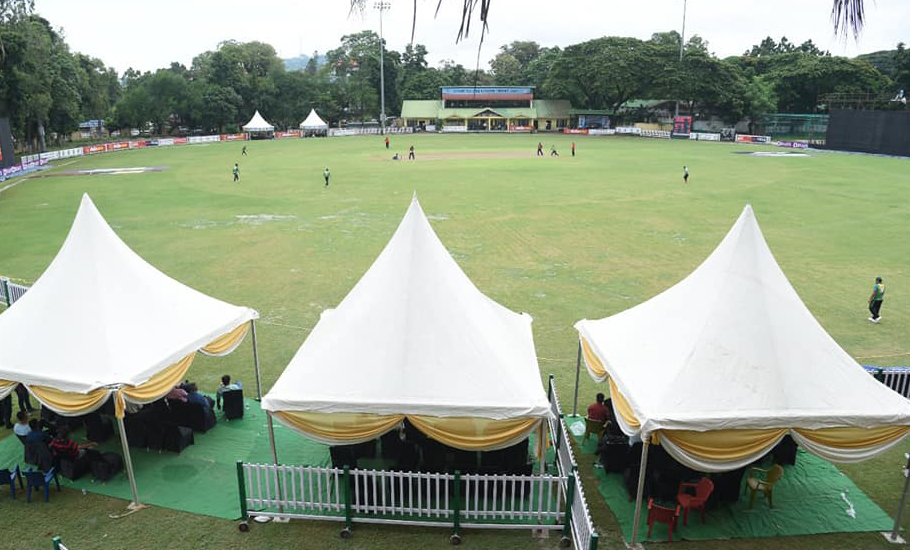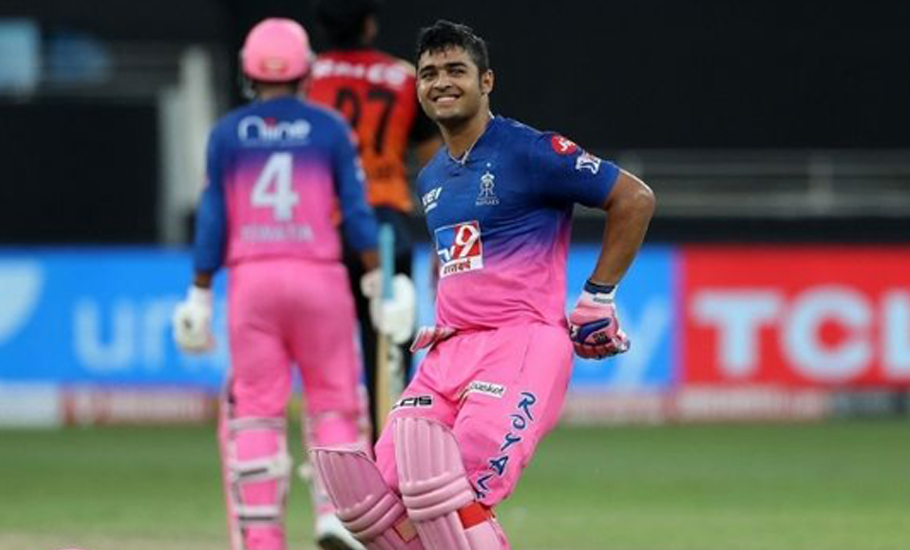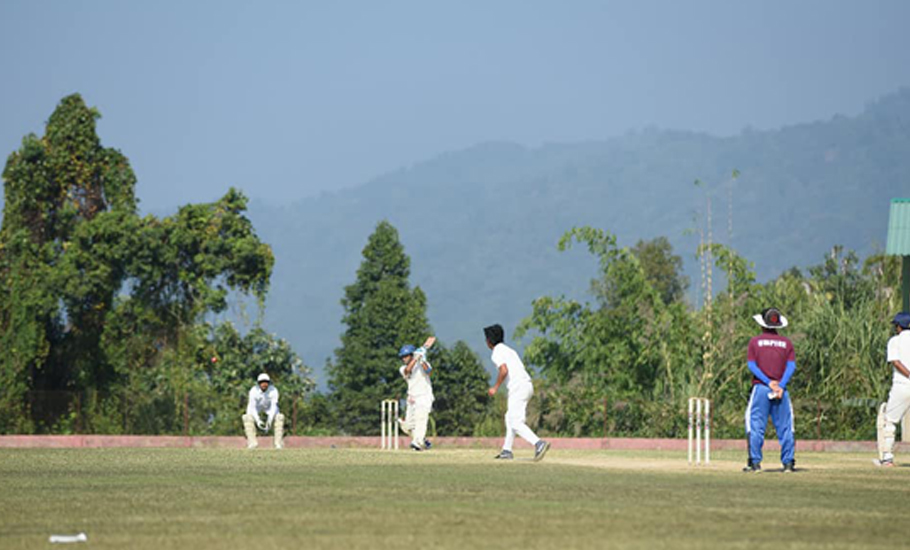
- Home
- News
- Analysis
- States
- Perspective
- Videos
- Education
- Entertainment
- Elections
- World Cup 2023
- Features
- Health
- Business
- Series
- Economy Series
- Earth Day
- Kashmir’s Frozen Turbulence
- India@75
- The legend of Ramjanmabhoomi
- Liberalisation@30
- How to tame a dragon
- Celebrating biodiversity
- Farm Matters
- 50 days of solitude
- Bringing Migrants Home
- Budget 2020
- Jharkhand Votes
- The Federal Investigates
- The Federal Impact
- Vanishing Sand
- Gandhi @ 150
- Andhra Today
- Field report
- Operation Gulmarg
- Pandemic @1 Mn in India
- The Federal Year-End
- The Zero Year
- Premium
- Science
- Brand studio
- Home
- NewsNews
- Analysis
- StatesStates
- PerspectivePerspective
- VideosVideos
- Entertainment
- ElectionsElections
- Sports
- Loading...
Sports - Features
- BusinessBusiness
- Premium
- Loading...
Premium

BCCI readies the pitch for cricket to score big in northeast India

On a pleasant evening in 2000, inside a militant hideout somewhere in Nagaland’s Mokokchung town, Kitovi Zhimomi sat surrounded by Kalashnikov- and Uzi-toting bodyguards. The general secretary of the dreaded National Socialist Council of Nagaland-Khaplang (NSCN-K) and his lieutenants weren’t planning any attack against Indian security forces. Instead, Zhimomi was engrossed watching...
On a pleasant evening in 2000, inside a militant hideout somewhere in Nagaland’s Mokokchung town, Kitovi Zhimomi sat surrounded by Kalashnikov- and Uzi-toting bodyguards. The general secretary of the dreaded National Socialist Council of Nagaland-Khaplang (NSCN-K) and his lieutenants weren’t planning any attack against Indian security forces. Instead, Zhimomi was engrossed watching an India-Pakistan cricket match live on TV. And if that wasn’t a surprise enough, he was actually rooting for India!
“It’s just a fun game. Don’t try to make it a serious issue by mixing up politics and nationality,” he had said when asked about his contested allegiance.
Before taking up guns, the militant leader wielded the willow and was known for his big-hitting prowess. But like most youth of his generation in Nagaland, his cricketing dream had little room for fruition. Naturally, it did not take him anywhere.
Zimomi’s unrequited love for cricket was symptomatic of the state of affairs in sports until a couple of years ago in all the hilly northeastern (NE) states barring Assam and Tripura, two old affiliates of the Board of Control for Cricket in India (BCCI).
“It was the players who used to multitask as sports organisers, raising funds from well-wishers and even contributing from their own pockets to organise tournaments,” said P Bendang Jamir, known as the father of cricket in Nagaland.
The scenario was more or less the same in almost all hill states, said Subudh Malla Baruah, sports journalist and writer from Assam. It was a few cricket enthusiasts who kept the game ticking in the absence of adequate funds, infrastructure, and more importantly, motivation.
BCCI’s push
That was before the Justice RM Lodha committee prodded the BCCI to bring the remaining six states—Arunachal Pradesh, Mizoram, Meghalaya, Nagaland, Manipur and Sikkim—under its affiliation in 2018-19.
The affiliation after years of deprivation finally provided an opportunity to cricketers from these states to exhibit their cricketing skills on the national platform, participating in major BCCI-organised domestic tournaments like Ranji Trophy, Vijay Hazare Trophy, Syed Mushtaq Ali Trophy and Vinoo Mankad Trophy.

The players from the region can now not only showcase their talents before national selectors at the first-class level domestic cricket tournaments, but also earn decent money to take up cricket as a full-time profession.
The per day per match fee for the top Ranji cricketers, who have played more than 40 matches, is Rs 60,000, which means such players earn Rs 2.40 lakh from a four-day Ranji match. Those who have played 21 to 40 matches are paid Rs 50,000, while players with experience less than that are entitled to a remuneration of Rs 40,000 per day.
The affiliation further ensured that the cricket association of these states gets funds from the BCCI to promote the game. “Each of these state units has been getting Rs 10 crore every year since 2019 for the development of cricket in their respective state,” said Jamir, who was the vice-president of the Nagaland Cricket Association when the BCCI opened its doors to the northeastern states.
As part of its northeast outreach programme, the world’s richest cricket governing body last month also earmarked Rs 60 crore for six new members for development of indoor practice facilities. As these states experience extended rainy seasons lasting almost six months, their Ranji teams hold practice sessions outside the region.
Currently, conditioning camps for Ranji squads of Meghalaya and Sikkim are being held in Puducherry. The Mizoram team is training in Bengaluru.
“We roughly spend around Rs 3 crore every season to send the team to practice outside,” said Khairul Jamal (Mamon) Majumdar, general secretary of the Mizoram Cricket Association and an Indian Premier League (IPL) governing council member.
“The indoor facility would immensely help players as they would be able to utilise it round the year… even during off season,” said Hruaimawia Bawngkawn, vice-captain of the Mizoram team. In 2020, the team had to sit out the entire rainy season as it could not go out for the conditioning camp due to the pandemic.
The indoor practice centres will be developed at a cost of Rs 10 crore each at Dimapur in Nagaland, Shillong in Meghalaya, Itanagar in Arunachal Pradesh, Aizawl in Mizoram, Imphal in Manipur and Gangtok in Sikkim.
Each centre will have three state-of-the-art pitches with bowling machines, besides gym and a swimming pool.
IPL debut
Another good news for cricket in the northeast is the inclusion of Guwahati in the list of eligible cities to bid for IPL 2022. The names of two new franchises to be inducted from Guwahati, Ranchi, Cuttack, Ahmedabad, Lucknow, and Dharamsala will be announced on October 25.
A base price of Rs 2,000 crore has been fixed for each of the two new teams. But BCCI sources said they expect that each team would ultimately be sold for a minimum of Rs 3,000 to Rs 3,500 crore.
Guwahati, along with Ahmedabad and Lucknow, is a frontrunner to bag one of the two slots, the sources added.
“It will be a great boost to cricket in the northeast if Guwahati can ultimately win the bid. The city has requisite infrastructure to have an IPL franchise. Moreover, it will be a home team of eight states,” said Naba Bhattacharjee, a member of the BCCI taskforce to promote cricket in the north-east.
Will that be enough to produce national-level cricketers from the region that has of late been doing extremely well in Olympic sports?
No cricketer from the region has ever played for the national team. Abu Nechim Ahmed and Javed Zaman of Assam are the only ones from the northeast to have made it to the India ‘A’ team. A handful of other players such as Khanin Saikia, Abu Nechim and Riyan Parag Das featured in India’s Under-19 squad.

Riyan, son of former Assam cricketer Parag Das and national record holder swimmer Mithu Baruah, is the only player from the region to find a place in the main team of an IPL franchise in the money-spinning tournament’s just concluded fourteenth season. Nagaland’s 16-year-old leg-spinner Khrievitso Kense was selected as a support player for the Mumbai Indians. Earlier, Hokaito Zhimomi of Nagaland, who was playing for Assam, was part of the Kolkata Knight Riders in 2008 and 2009 but didn’t get to play any match.
“The region needs to do lots of catching up. Historically, like everywhere in India, cricket being an urban-centric expensive elite sport, its reach in the region, until recently, was limited to a few big cities and towns,” said Baruah.
Even in the urban centres of the region, there is a lack of proper infrastructure like good pitches. The scenario was the same even for Assam, which has the oldest cricket association in the region formed in 1948, exactly a hundred years after the first Indian cricket club, the Oriental Cricket Club, was established by the Parsi community of Mumbai.
In the very first major match organised by the Assam Cricket Association, it faced infrastructural challenges that continued till the BCCI started pouring money into the game after its coffers swelled following the Reliance World Cup of 1987, Baruah added.
The match between Assam and the United Province (present-day Uttar Pradesh) in 1948 had to be shifted from Jorhat to Shillong, which was then the capital of undivided Assam, as there wasn’t any proper pitch or the required 8-feet-long cricket mat at the original venue, he pointed out.
Outside two relatively plain states of Assam and Tripura, finding a flat surface to build cricket grounds was also a major challenge, Baruah added to explain why cricket has failed to reach every nook and cranny of the region as it has been in rest of India.
“We need to build at least one proper stadium in each district to promote the game in remote areas. But to find enough space for that is a big challenge in a hilly state like Nagaland. To construct a stadium by flattening hills needs lots of money,” said Jamir endorsing Baruah’s view.

Now that the BCCI is supporting the game in the region, Jamir is hopeful that getting funds at least will not be a problem for infrastructure development.
Fear of graft
Given the region’s track record of corruption, many former and current players and cricket enthusiasts The Federal spoke to feel that the BCCI should very strictly monitor utilisation of funds.
“We know how over the years the state governments of the region misutilised funds pumped in by the Centre for the development of the region. The same should not be the case with the money the BCCI is now giving for the development of the game,” said Timir Choudhury, former cricketer from Nagaland.
They have reasons to be sceptical. Nagaland, Manipur and Arunachal Pradesh are already embroiled in pay-and-play scam.
The Delhi Police filed a case in 2019 on a BCCI complaint that three aspiring Delhi cricketers had allegedly paid Rs 80 lakh to coaches and officials of the cricket boards of Nagaland, Manipur and Jharkhand on the promise that they would be selected in the Ranji Trophy teams of their respective state.
A little-known Delhi player Khsitiz Sharma’s inclusion in Arunachal Pradesh’s list of Ranji guest players in 2018 also came under the scanner with the team struggling to explain why he was picked over more accomplished domestic cricketers.
Even the BCCI is aware of the pitfalls. “To ensure that there is more accountability and proper planning for utilisation of Rs 60 crore that the BCCI proposed to allot to the six north-eastern states, the North East Coordination Committee of the board held a meeting in Dimapur on October 8,” Bhattacharjee said.
Surely, corruption in the state boards could be a major challenge along with hostile weather and terrain for the development of the game in the region, said Baruah.

